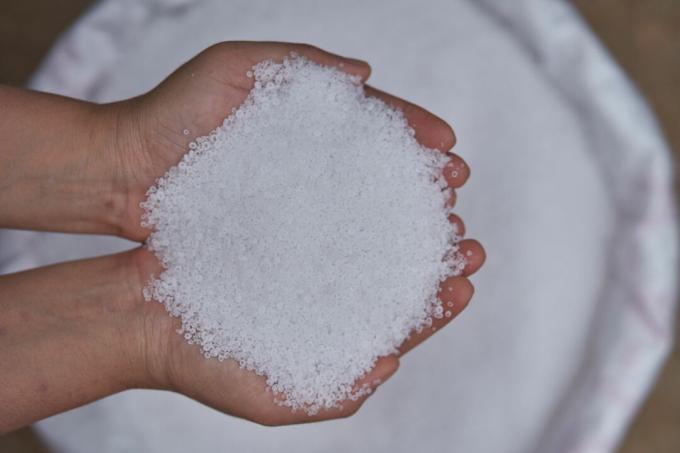Epsom salt is a very special plant fertilizer. We will show you what is characteristic of Epsom salt and what it can be used for in the garden.

Some of you will not know Epsom salt as a fertilizer, but from its medicinal use. On the one hand, we find Epsom salt in so-called heat packs, which generate therapeutic heat, and on the other hand, Epsom salt is used as a laxative. However, it can also be used as a fertilizer. You can find out exactly how this works here.
contents
-
Epsom salt: what is it?
- Composition of Epsom salts
-
Use Epsom salt as fertilizer
- Epsom salt: what for & when to use?
- Epsom salt as fertilizer: how often to use?
- Buy Epsom salts
Epsom salt: what is it?
The substance magnesium sulfate (MgSO4), a colorless and odorless powder that tastes extremely bitter. Hence its name - Epsom salt. Outwardly it is similar to the normal salt that we know from the kitchen, but Epsom salt consists of completely different substances.
Composition of Epsom salts
As already mentioned, Epsom salt is magnesium sulfate, so it consists of magnesium and sulfate, which is, simply put, sulfur. Now it is also clear which deficiency symptoms Epsom salt can be used for, namely with magnesium and sulfur deficiency.
On average, Epsom salt consists of 16% magnesium and 13% sulfur. However, these levels can vary from provider to provider or depending on the product used. You can always find the exact content of your Epsom salts on the packaging.
Use Epsom salt as fertilizer
Epsom salt is used in universal fertilizers as a source of magnesium. So it is either mixed with fertilizers or it is used as a pure substance in order to compensate for a magnesium deficiency in a targeted manner.

Epsom salt: what for & when to use?
Before we dive into the use of Epsom salts, let's look at the magnesium in the soil. There are some factors that affect magnesium that we need to look out for when fertilizing. This includes the pH value, because the solubility of nutrients in the soil always depends on it. Magnesium is best available at a relatively neutral pH value (6 to 8) and is therefore also accessible to plants. But when the soil becomes acidic or excessively basic, the magnesium is no longer available. If you fertilize with Epsom salt, which consists of magnesium sulfate, you should consider that this lowers the pH value in the soil. When the pH falls below 6, the magnesium solubility is decreased. Then, in principle, you can fertilize as much as you want - the plant will not preserve the substance. For this reason, if you are having major nutrient supply problems in your garden, consider doing a soil survey.
When fertilizing magnesium, one should always keep an eye on another nutrient, namely calcium. If there is a lot of calcium in the soil, this can reduce the availability of other nutrients - for example magnesium, potassium or phosphorus. Therefore, always pay attention to a balanced nutrient ratio in the soil and avoid one-sided fertilization. Suffer particularly often Conifers (Conifers) in our gardens under magnesium deficiency and show this by yellow or brown discolored needles. Other plants also show a magnesium deficiency when their leaves turn yellow. First the older leaves change color and slowly the yellow color spreads to the younger ones. In the case of the discolored leaves, however, the leaf veins remain green and the performance of photosynthesis decreases, because magnesium is an important part of the leaf green, the chlorophyll.

Unfortunately, in the case of conifers, the discoloration alone cannot clearly indicate a magnesium deficiency. A lack of potassium can also cause the needles to discolour. Most of us are familiar with such discoloration and the browning of needles from thuja hedges in the garden. You can use Epsom salts during the growing season, generally between March and November. Use outside the growing season is not recommended, as the magnesium sulphate can then simply be washed out and has no effect on our plants.
Since Epsom salt only fertilizes very unilaterally, a soil examination should be carried out before use. In any case, we recommend not only fertilizing with Epsom salt, but also using a balanced organic fertilizer, such as ours Plantura organic universal fertilizer. This contains essential nutrients with which your plants are nourished in a balanced way.
Epsom salt as fertilizer: how often to use?
For maintenance fertilization with Epsom salt, it is first important to know what soil you have. If your soil is rather light, i.e. very sandy, and water seeps away faster, then more magnesium is washed out. In such light soils, two to three doses of 30 g Epsom salt per square meter are recommended.
If you have heavy soil in the garden that is very loamy and tends to become waterlogged, once a season 30 to 50 g of Epsom salt per square meter is sufficient for sufficient magnesium fertilization.

You can use the Epsom salt fertilizer in several ways:
- Work the Epsom salt in solid form into the soil and then water the area thoroughly
- Dissolve the Epsom salt in water and water the plants with symptoms of deficiency
- Epsom salt can also be administered via foliar fertilization. Since magnesium is also present in the green of the leaves, it can be easily supplied in this way. A solution of about 20 ml of liquid Epsom salt in one liter of water is ideal for foliar fertilization
Buy Epsom salts
Epsom salt is available as a solid fertilizer, but also in liquid form. Basically, Epsom salt is relatively cheap to get, sometimes starting at a kilo price of around one euro. Epsom salt is also added to some universal fertilizers for an extra portion of magnesium.
General information on the properties and use of Magnesium fertilizers see this article.
